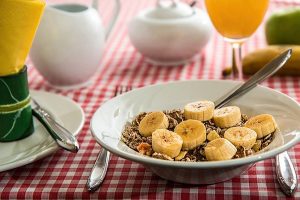Nutrition: Fantastic fiber
 Looking for a new spin on meal prep? One way is to focus on fiber. You’ll suddenly find your plate crowded with colorful vegetables, new grains and tasty spices!
Looking for a new spin on meal prep? One way is to focus on fiber. You’ll suddenly find your plate crowded with colorful vegetables, new grains and tasty spices!
Besides turning your approach to dinner upside-down, increasing your dietary fiber has positive effects on the prevention of many health complications like high cholesterol, high blood sugars, colorectal cancers and poor digestive health. A high-fiber diet is also often lower in calories and can increase feelings of fullness after meals—meaning, your new high-fiber cuisine also can promote a healthy weight!
What is fiber?
Fiber is a type of indigestible carbohydrate found in plant foods such as fruits and vegetables, nuts and seeds, and whole-grain products. Fiber helps to bind dietary cholesterol before absorption and excrete it from the body, assisting in lowering overall cholesterol levels in the body. Also, in the large intestine, some fiber is fermented and transformed into a short-chain fatty acid, which then communicates with the liver to halt further production of cholesterol internally. A double win for your cholesterol numbers!
Lastly—and in honor of March being Colon Cancer Awareness Month—know that fiber feeds your gut’s beneficial bacteria that facilitate with proper digestion and immunity, thus reducing your risk for colon cancer and diverticulitis.
How much should I eat?
The recommended amount of fiber is 25 grams per day for women and 38 grams per day for men (or for those over the age of 51, 21 and 30 grams per day, respectively). Unfortunately, most Americans are falling far short of the recommended amount.
How do I add fiber to my diet?
When increasing your fiber intake, start slow and drink plenty of fluids, especially if taking any supplemental forms of fiber.
Here are some simple substitutions that can easily add more fiber into your diet:
- Snack on fruits and vegetables during the day.
- Have steel cut or rolled oats with nuts and berries for breakfast instead of cereal.
- Try avocado toast on whole-grain bread.
- For lunch, use whole-grain bread products and add veggies such as tomatoes, cucumber and spinach to sandwiches or wraps.
- Try vegetable-spiralized “noodles” as your lunch or dinner base (either pre-packaged or make your own) using butternut squash, zucchini or sweet potatoes.
- Toss an extra handful of vegetables or beans into casseroles and stews.
- Try brown rice, quinoa or lentil-based pasta instead of refined grains.
- Add oat bran or flour to home-baked items such as cookies and muffins and to savory dishes like meatloaf.
Any shopping tips?
Look for Dietary Fiber content on the Nutrition Facts label. It’s listed under Total Carbohydrates. A great source of fiber provides typically 5 grams or more per serving, while a good source provides 2.5 to 4.9 grams per serving.
Healthy eating!


